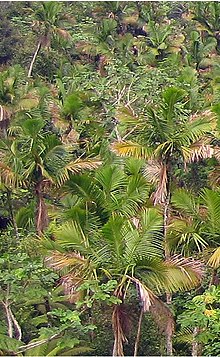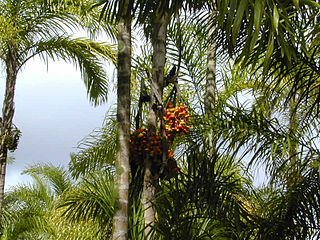
Bactris is a genus of spiny palms which are native to Mexico, South and Central America and the Caribbean. Most species are small trees about 2 m tall, but some are large trees while others are shrubs with subterranean stems. They have simple or pinnately compound leaves and yellow, orange, red or purple-black fruit. The genus is most closely related to several other spiny palms—Acrocomia, Aiphanes, Astrocaryum and Desmoncus. The fruit of several species is edible, most notably B. gasipaes, while others are used medicinally or for construction.
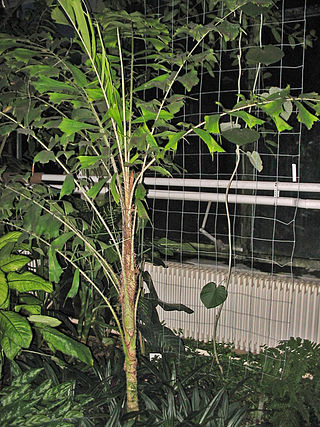
Aiphanes is a genus of spiny palms which is native to tropical regions of South and Central America and the Caribbean. There are about 26 species in the genus, ranging in size from understorey shrubs with subterranean stems to subcanopy trees as tall as 20 metres (66 ft). Most have pinnately compound leaves ; one species has entire leaves. Stems, leaves and sometimes even the fruit are covered with spines. Plants flower repeatedly over the course of their lifespan and have separate male and female flowers, although these are borne together on the same inflorescence. Although records of pollinators are limited, most species appear to be pollinated by insects. The fruit are eaten by several birds and mammals, including at least two species of amazon parrots.

Licuala is a genus of palms, in the tribe Trachycarpeae, commonly found in tropical forests of southern China, Southeast Asia, the Himalayas, New Guinea and the western Pacific Ocean islands.

Aiphanes horrida is a palm native to northern South America and Trinidad and Tobago. Aiphanes horrida is a solitary, spiny tree. In the wild it grows 3–10 metres tall tall with a stem diameter of 6–10 centimetres ; cultivated trees may be as much as 15 m (49') tall with a 15 cm (6") diameter. The epicarp and mesocarp of the fruit are rich in carotene and are eaten in Colombia, while the seeds are used to make candles. In parts of the Colombian Llanos, endocarps are used to play games.

Bactris setulosa is a medium-sized spiny palm which is found in Colombia, Venezuela, Ecuador, Peru, Trinidad and Tobago and Suriname. It is one of the largest species of Bactris and is found at the highest elevations.
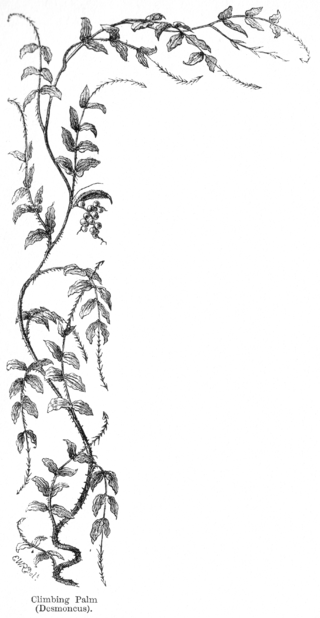
Desmoncus is a genus of mostly climbing, spiny palms native to the Neotropics. The genus extends from Mexico in the north to Brazil and Bolivia in the south, with two species present in the southeastern Caribbean.

Oenocarpus is a genus of pinnate-leaved palms (Arecaceae) native to Trinidad, southern Central and tropical South America. With nine species and one natural hybrid, the genus is distributed from Costa Rica and Trinidad in the north to Brazil and Bolivia in the south.

Prestoea is a genus of palms native to the Caribbean, Central and South America. Its range extends from Nicaragua and the Greater Antilles in the north to Brazil and Bolivia in the south.

Rodrigo Bernal González is a Colombian botanist who specialises in the palm family. Bernal was a faculty member at the Institute of Natural Sciences, National University of Colombia until 2007. He received his Ph.D. from the University of Aarhus, Denmark, in 1996. He was general curator of the National Colombian Herbarium (1986-1987), and editor of the scientific journal Caldasia.

Pinanga is a genus of flowering plant of the palm family in the subtribe Arecinae. It is native to eastern and southern Asia across to New Guinea.

Wettinia is a genus of flowering plants in the palm family Arecaceae. The genus, established in 1837, contains some 20 species, but more seem to await discovery considering that 4 species - W. aequatorialis, W. lanata, W. minima and W. panamensis - were described as late as 1995. The genus is broadly divided into two groups. One group has the fruits tightly packed, while the other, formerly classified as genus Catoblastus, has fruits scattered along the inflorescence branches. It is not known whether these groups are both monophyletic. The genus is named after Frederick Augustus II of Saxony, of the House of Wettin.

Desmoncus polyacanthos, the jacitara palm, is a spiny, climbing palm native to the southern Caribbean and tropical South America. Stems grow clustered together, and are 2–12 m long and 0.5–2 cm in diameter. Petioles, rachis, cirrus and peduncular bracts are covered with short, curved spines. Two varieties are recognised: D. polyacanthos var. polyacanthos and D. polyacanthos var. prunifer A.J.Hend.

Euterpe precatoria is a tall, slender-stemmed, pinnate-leaved palm native to Central and South America and Trinidad and Tobago. E. precatoria is used commercially to produce fruits, although Euterpe oleracea is more commonly cultivated due to its larger fruits.
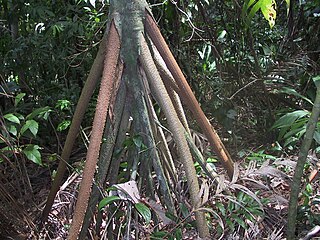
Socratea is a genus of five species of palms found in tropical Central America and South America.

Pholidostachys is a genus of palms found in Central America and northwestern South America.

Lepidocaryum is a monotypic genus of flowering plant in the palm family from South America where the lone species, Lepidocaryum tenue, is commonly called poktamui. Nine species names have been published, but palm taxonomists currently agree that just one variable species includes them all. The most reduced member of the Lepidocaryeae, it is similar in appearance to three closely related genera, Mauritia, Mauritiella, and Lytocaryum. The genus name combines the Greek words for "scale" and "nut" and the species epithet is Latin for "thin".

Oenocarpus bataua, the patawa, sehe, hungurahua (Ecuador) or mingucha, is a palm tree native to the Amazon rainforest. The tree produces edible fruits rich in high-quality oil.
Euterpe catinga is a palm species in the genus Euterpe. It is found in forests of a dry, sandy soil and very peculiar vegetation, known as catinga forests or Campinarana in northern South America.

Prestoea acuminata var. montana is a perennial palm in the family Arecaceae.
